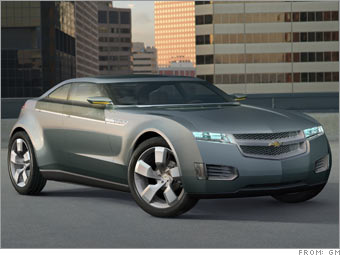The other, called the E-flex platform, is the basis of the Chevrolet Volt concept car.
The Volt is an electrically-driven vehicle. Its wheels are turned by electric motors that draw power from a battery. The battery, in turn, is charged by plugging into an electrical socket. One overnight charge should be good for 40 miles of driving.
If the Volt runs low on power, its small gasoline engine would start up to recharge the battery on the fly.
But that gasoline engine could be a hydrogen fuel cell instead. That way, the Volt would be a full-time zero-emissions vehicle even when generating its own power.
Allowing the vehicle to charge from a wall outlet would mean greater range. The downside is that a system like this requires battery technology that doesn't yet exist. The batteries would have store and release enough energy to drive a vehicle at full speed without assistance from an engine or fuel cell.
The batteries would also have to stay cool and last the life of the vehicle. GM is working with two battery companies to research possible solutions, but there is no guarantee the problems will be solved any time soon.
Other car companies have expressed skepticism about GM's E-Flex plan. Ford, for instance, has a drivable plug-in fuel cell vehicle but has made it clear it has no notion of bringing such a vehicle to market in the foreseeable future.
Toyota has also said the battery technology required for viable plug-in vehicles will not be available soon.

